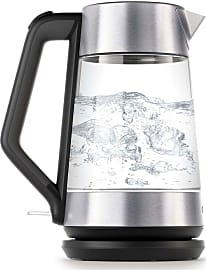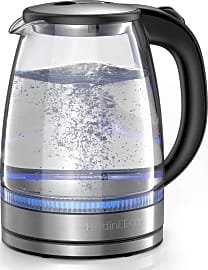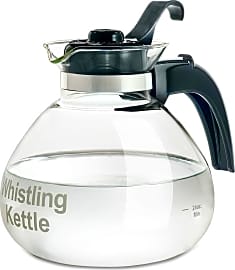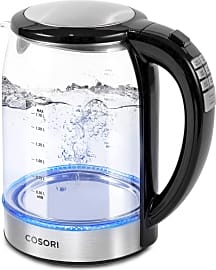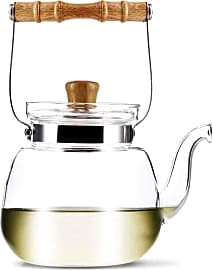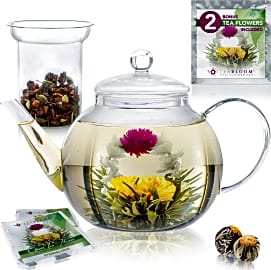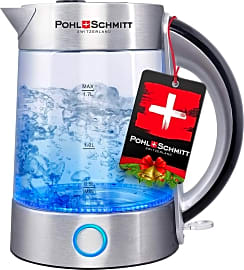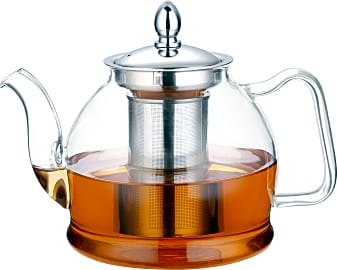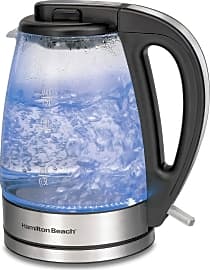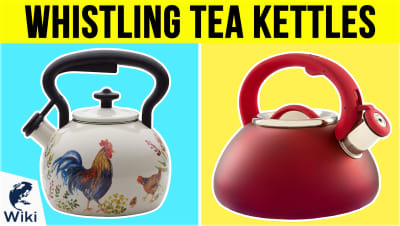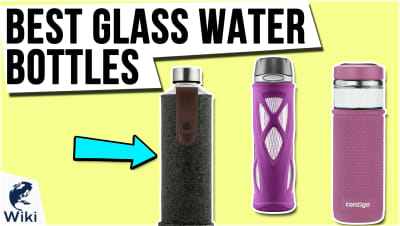The 10 Best Glass Kettles

This wiki has been updated 40 times since it was first published in April of 2016. Whether you don't like the heftiness of metal and steel models or you simply prefer an elegant look, these glass kettles will boil water for you in no time, and let you see inside to watch those bubbles form. We've included both electric options and stovetop designs, allowing you to choose whichever suits your needs, so you can enjoy a nice cup of tea or cocoa anytime. When users buy our independently chosen editorial recommendations, we may earn commissions to help fund the Wiki.
Editor's Notes
November 27, 2020:
Although we appreciate the designs of the Teabloom Blue Rainbow, the Molla Puro, and the Breville IQ Pure, all three have issues with their lids, prompting us to remove them. In fact, we are disappointed overall by Breville in this area. The company is known for producing high-quality, reliable kitchen gear, but we found too many complaints about their glass kettles, making them hard to recommend at this time — although this shouldn't stop you from considering their other appliances. We've also removed the Ovente KG83B, even though we appreciate the fantastic color range offered. There are too many reports of it failing and causing injury to the user, a problem that's hard to overlook.
Instead, look to the Mueller Premium or the Oxo Brew if your needs are simple, and the Cosori Heater if you need something with more precise temperature control. Each is easy enough to use, and each illuminates in some way to let you know that it's on and functioning. We kept the popular Hamilton Beach Electric 40864, too, but note that you'll have to be sure it's closed securely; otherwise, it may not shut off automatically, as it's supposed to.
For those who prefer a non-electric choice, the Hiware 33-GT and the Yama Teapot still make fine options, as does the Cafe Brew Collection Whistling, as long as you treat it with care. This latter model has a few plastic pieces that can melt if you use it on a high heat setting or let it sit for too long on a medium one. Fortunately, however, it's a whistling kettle, just as its name suggests, so you'll know when the water is ready.
May 30, 2019:
Glass kettles can offer a lot more than just the ability to see inside the pitcher and monitor your water. We selected models with a range of features that make tea time more enjoyable and easier. Some of our top picks cater towards avid tea connoisseurs, like the Willsence KT-S1, which automatically selects the perfect steep time and temperature for your selected type of tea, removing the guesswork around when your cup is ready. The Teabloom Blue Rainbow is entirely clear with a fish bowl shape, making it easy to watch the included enchanting flowering blooming balls open up and infuse the water with their flavors. It's also just so pretty that it's worthy of high tea with guests. Meanwhile, the Hiware 33-GT has a removable infuser, so you can do your steeping within the pot, or not. We also know that the times of the day people need a little liquid pick-me-up are also some of the busiest, which is why we selected a few smart and modern models to make brewing that perfect cup a breeze. The Willsence KT-S1 stands out again, since its auto-start feature allows you to program the machine to start brewing for you at select times. The Cafe Brew Collection Whistling whistles loudly when it's done, so if you're rushing around getting ready while this thing works, it will notify you to return to the stove just in time. The Hamilton Beach Electric 40864 emits a blue light when it is working, so there's no need to keep checking on it to make sure your water is boiling.
Special Honors
Chemex Handblown The Chemex Handblown has an elegant shape that sets it apart from the competition, while the strong, non-porous glass from which it's crafted ensures that it's durable and usable. You'll need to be careful when picking it up after heating, though, as you must grip it by the neck instead of a heat-resistant handle. chemexcoffeemaker.com
Why Glass Kettles Are King
Unless you've been living under a rock for the past several years, you've seen the dire warnings about heating foods and beverages in various types of plastics and metals.
Unless you've been living under a rock for the past several years, you've seen the dire warnings about heating foods and beverages in various types of plastics and metals. Although some, like the admonition against using aluminum, have been generally debunked, others, like the disapproval of BPA, remain. And in fact, some of the replacements for these materials may have problems of their own. For example, plastics free from BPA could contain BPS, a material that may be just as harmful.
You don't have to despair of ever having a cuppa that doesn't seem to spell grim death, though. Glass kettles provide an alternative to metal and plastic models that skirts the attendant problems in other materials: metallic taste, unnatural chemicals, rust, and more. That's because lead-free glass doesn't leach toxins into your water, no matter how long you use it for boiling. It can't transfer flavors, either, so you won't ever get that weird, sucking-on-pennies taste that comes from a lot of metal kettles. And since many come with a limescale filter, you won't be stuck googling "how to get this horrible filthy gunk off my kettle" every six months.
There's one caveat to heed, however, and it's this: If the heating element touches the water, it'll need to be safe, too. The cleanest, most stylish glass kettle in the world loses major points if it's got a substandard heating element submerged in the water, since this element could very well create unwanted flavors or become covered with scale. Fortunately, most glass kettles nowadays feature a concealed heating element, leaving you with nothing to worry about.
Of course, if you're truly hardcore, you may not want metal or plastic touching your water at all. For this, manufacturers make all-glass models that heat up on your stovetop. These elegant versions have no metal heating elements, no plastic base, no bells and whistles — nothing but clean glass to heat your water the old-fashioned way. Sure, they may not be as fast, but what you lose in speed, you make up for in charm.
Heat Your Water Your Way
Once you're sold on the idea of a glass kettle, you might rush out to buy one, only to hit a wall of further options. Lighted or plain? Temperature adjustable or automatic? Small, medium, or large? Such choices may seem flummoxing, but really, all you must do is reflect a bit on how you plan to use your new device.
Perhaps the last choice you'll have to make relates mostly to style and a little to functionality.
First of all, do you entertain company regularly, have a large family of hot beverage drinkers, or consume many teas and/or coffees quickly and in rapid succession? If so, then a large-capacity model will do nicely. These usually hold up to around seven cups, or about 60 ounces, which lets you quickly offer tea to an entire gathering. If, on the other hand, you live alone or with people who are averse to delicious warm libations, then a smaller unit may suit you better.
Next, you might think about the level of precision you expect from your glass kettle. Green tea, for example, should be brewed at around 160 to 170 degrees Fahrenheit, which is lower than the boiling point of water. A kettle that merely boils water, then, will offer you liquid that's too hot, leading to scalded, bitter tea. Coffee, too, can suffer when brewed with too-hot water; the best temperature for a smooth brew is between 195 and 205 degrees Fahrenheit. For those who honor these distinctions, glass kettles that provide temperature control and selection are probably the best choice. Many also have a "keep warm" feature that — you guessed it — it keeps the water heated until you're ready for your next cup.
Perhaps the last choice you'll have to make relates mostly to style and a little to functionality. Many glass kettles are now of the light-up variety, tastefully illuminating the water through the glass, usually in blue. This not only lends a futuristic air to your tea- or coffee-making, but it also serves as a quick indicator that the kettle is, in fact, on and working. It's entirely possible that you might find this annoying, especially if you're one of many people who are tired of the seemingly unavoidable and constant glow of device lights.
One choice you probably won't have to make, fortunately, is between cordless and corded. Most manufacturers now locate a unit's electrical cord in the base, so you can pick up the kettle and pour with ease.
How Do Electric Kettles Work, Anyway?
You can look right through your glass kettle and watch the water boil, but doing so probably won't give you any clearer idea about how it actually works. Sure, you can see where the heat comes from, but how does it know how hot is hot enough? And what on earth makes it stop heating when the water is ready?
How the kettle works is dependent upon what type of heating element it uses. On the simpler side, we find those that are mechanical and rely on a bimetallic thermostat. When you turn the kettle on, two types of metal begin to heat up, but one of these expands faster than the other. Once the water starts to boil, the temperature forces one of the pieces of metal, the quicker-expanding one, to flex. In so doing, it snaps open, trips a circuit, and kills the electric current. Your kettle turns off, so you'll never have to fret that you've forgotten to stop it.
Glass kettles that are more sophisticated, the ones that can heat your water to a precise temperature, rely on electronic thermostats. These have a brain that allows them to perform more complex functions, such as switching the current on and off to keep the water at a certain temperature, as in the case of a "keep warm" function.


